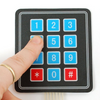
Punch in your secret key into this numeric matrix keypad. This keypad has 12 buttons, arranged in a telephone-line 3x4 grid. It's made of a thin, flexible membrane material with an adhesive backing (just remove the paper) so you can attach it to nearly anything. The keys are connected into a matrix, so you only need 7 microcontroller pins (3-columns and 4-rows) to scan through the pad.
Adafruit includes a 7-pin extra-long header strip so you can plug this into a breadboard with ease.
- Weight: 7.5 grams
- Keypad dimensions: 70mm x 77mm x 1mm (2.75" x 3" x 0.035")
- Length of cable + connector: 85mm
- 7-pin 0.1" pitch connector
There is a very nice Matrix Keypad Arduino library that works great with this item. The only thing we suggest is to change the initialization code in the examples to this:
#include "Arduino.h" #include "Keypad.h" const byte ROWS = 4; //four rows const byte COLS = 3; //three columns char keys[ROWS][COLS] = { {'1','2','3'}, {'4','5','6'}, {'7','8','9'}, {'*','0','#'} }; byte rowPins[ROWS] = {8, 7, 6, 5}; //connect to the row pinouts of the keypad byte colPins[COLS] = {4, 3, 2}; //connect to the column pinouts of the keypad Keypad keypad = Keypad( makeKeymap(keys), rowPins, colPins, ROWS, COLS );
This will swap the * and # keys and also let you connect to the Arduino to match this image




